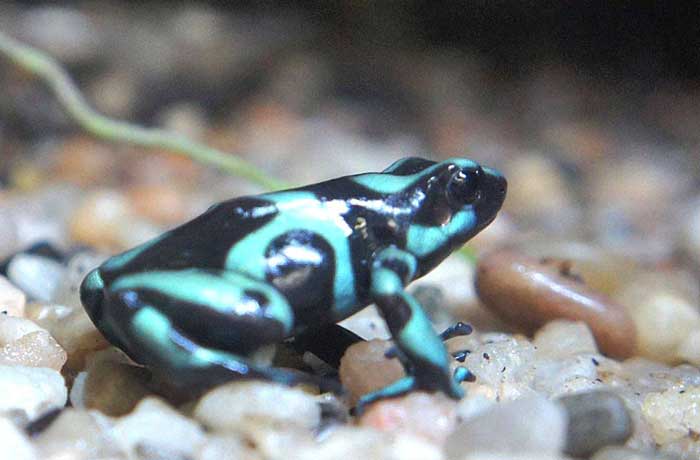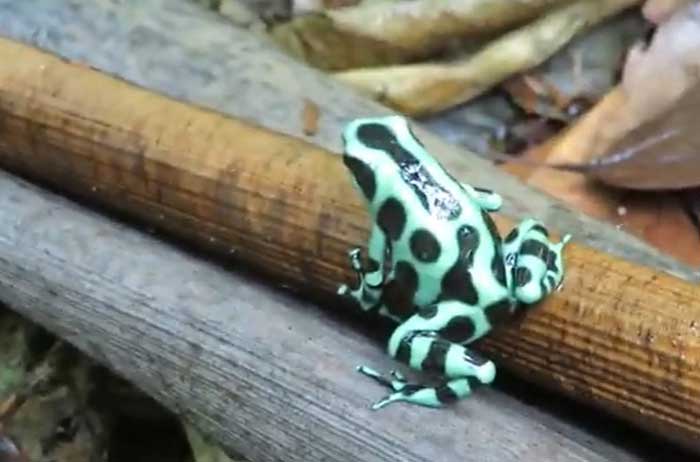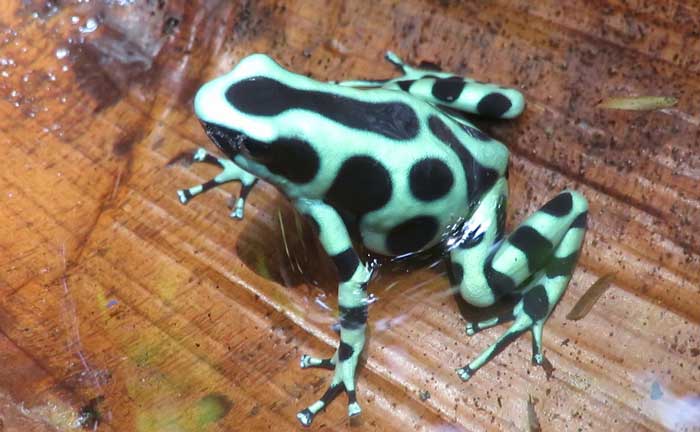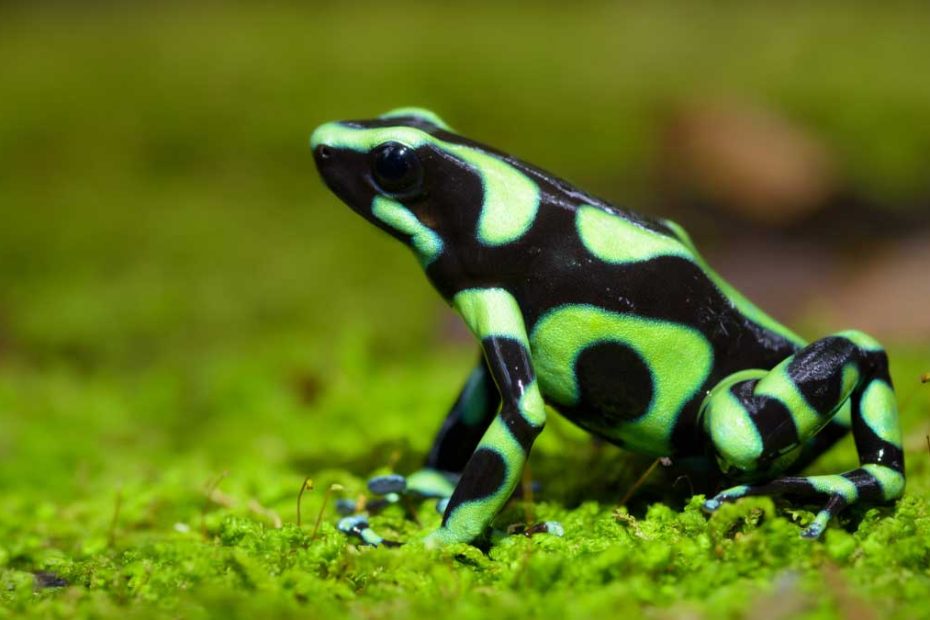The black and green poison frog (Dendrobates auratus) is named after its vivid mint green coloration and glossy black markings. These colors don’t just give the frog its beauty. They act as a warning to potential predators that this frog is poisonous and they should keep off! Like other poison dart frogs, this species releases toxins that can easily paralyze or even kill potential predators.
In this article, we’ll walk you through more in-depth details about this rainforest inhabitant as we uncover this unique behavior and characteristics. Moreover, we’ll discuss some commonly asked about this frog including its population size, and toxic nature, and some fun facts about it. If you would like to keep this toad as a pet, we’ll also share info on where to buy one.
An Overview of the Green and Black Poison Toad
The green and black poison frogs are small species native to the Central and South American rainforests.
Their geographical range extends from Costa Rica and Nicaragua to Southeast Bolivia and Brazil. Check out this map showing the poison frog’s geographical range.
These frogs have also been introduced to Hawaii, Oahu, and Maui by human activities where they have also flourished.

Adult frogs are mostly found on the damp floor of the rainforests and prefer inhabiting locations near watercourses such as small streams and pools, where their tadpoles can develop safely.
They usually occur at elevations of up to 2,640 feet (800 meters), with some mountain morphs occurring at even higher elevations of 3,869 feet (1200 meters).
An adult green-and-black poison frog’s coloration can vary, though most individuals are green, black, or light blue, with black spots or bands. They also have smooth and moist skin.
Males are unique with their barely distinct, wrinkled vocal sacs hanging the skin of their throats. They feature poison glands on their body surface.
They also have long, sticky, and retractable tongues that they use to capture prey. Moreover, their keen eyesight aids in capturing their prey.
These frogs are carnivores and prey on a variety of small invertebrates. Mind you, they get their toxicity from the foods they eat in the wild, which includes certain poisonous ant and insect species.
Green and black poison dart frogs are diurnal. You’ll seldom find them still during the day as they’re always searching for food in their habitats.
Mating for these frogs takes place throughout the rainforest’s entire rainy season, i.e. from mid-July all the way to mid-September.
Males are known to fight amongst themselves as they try to establish territories. These will then stay fixed for the rest of their mating season.
Males make trilling sounds to attract females for mating. After courtship, the females lay up to 6 eggs in small water pools. Males periodically return to the egg-laying site to check their eggs during their two-week development stage.
After the tadpoles hatch, the male carries them on its back and delivers them to a suitable place, e.g. a stream or lake where they can successfully develop to the next stage. The tadpoles take around 6 weeks to become adults.
The lifespan of these frogs in the wild is unknown. However, they have been observed to live for 6 to 10 years in captivity.
Here’s a video showing how the green and black poison frog looks like
Video:
Green and black poison dart frog scientific name
The green and black poison dart frog’s scientific name is Dendrobates auratus. The frog belongs to the family Dendrobatidae and genus Dendrobates, which comprises various poisonous dart frog species native to South and Central America.
Green and black poison dart frog size
The green and black poison frog measures 1.2 to 2 inches (3.1 to 5 centimeters) from snout to vent. Females are generally larger than males, averaging around an inch or two longer.

Green and black poison toad sound
Green and black poison dart frog produces a buzzing sound as a way of communicating with fellow frogs in the wild.
Males are known to be more vocal and produce this sound from breeding sites to attract females for mating during the breeding season.
Here’s a video of a pet green and black poison toad calling from its habitat setup
Video:
Green and Black Poison Dart Frog Population Size
There’s no existing data on the current green and black poison dart frog population size in the wild.
However, these frogs are currently classified by the IUCN Red List as species of Least Concern, meaning their numbers are stable in the wild and are at no risk of extinction.

That said, the IUCN also notes that the population trend of these species is on a downward trend. They have attributed this to the various threats the frogs are facing in the wild. These include:
- Habitat loss due to residential and commercial development
- Agricultural activities
- Pollution resulting from forestry and agricultural effluents
- Biological resource use, which includes wood logging and harvesting, and hunting/trapping of the terrestrial animals.
- Diseases such as chytrid fungi and ranavirus are also to blame for the declining black and green poison frog populations.
- Pet trade is another major issue causing the decline in the population of this species. The IUCN reports that approx. 62,000 payments of this species were involved in the pet trade between 1978 and 2008.
Is a Green Frog with Black Spots Poisonous?
In general, not all green frogs with black spots are considered poisonous. However, some species such as this green and black poison frog (Dendrobates auratus) are poisonous and use their vibrant hues as a warning of their toxic nature.
Most frogs and toads with striking coloration are poisonous to potential predators and even humans. This concept is known as aposematism (warning coloration). You can check out this study to find more details about this adaptation.

In the case of this black and green poison dart frog, it usually gets its toxins from the diet it feeds in the wild including some toxic species of ants and insects.
The frog releases its toxins when touched or bitten by a potential predator or even humans.
Note that the toxicity of this frog is considered moderate compared to that of other poisonous frogs and toads.
Green and Black Poison Toad for Sale
So you’re wondering where to get green-and-black and poison? There are many different options to consider when looking for this exotic frog pet.
You can start with your local pet store. Some local pet stores may sell exotic amphibians such as this frog.

Online communities and forums dedicated to amphibian and reptile enthusiasts may be another place to consider.
You may also consider looking for reputable breeders who specialize in captive-bred frogs.
Upcoming reptile and amphibian shows and expos are a great way to meet breeders and ask questions about this pet frog.
Remember to research your local laws regarding the ownership of exotic pets before you get this frog. The species may be protected or prohibited in some areas and owning them may require you to have a permit.
You should also keep in mind that these frogs have specific habitat and dietary requirements, which you should be able to meet to ensure their health and well-being.
Green and Black Poison Dart Frog Fun Facts

Here are some interesting facts you didn’t know about the green and black poison dart frog:
- Captive-bred green and black poison frogs are non-toxic. This is because the diet they feed on is different from that of their wild counterparts, which is what gives them (the wild ones) their toxicity.
- The frog uses its bright colors to warn all potential predators of its toxic nature. Predators usually recognize this bright coloration and avoid consuming it.
- Male green and black frogs are territorial and the females usually compete for access to them during the breeding season.
- There are more than 100 species of poison dart frog species, and the green and black frog is just one of them.
- Poison dart frogs are also known as arrow frogs. Some South American indigenous communities apply their toxins on the darts and arrows for hunting. This poison helps quickly kill the animals.
- The green and black poison frog was introduced in Hawaii in 1932 to help control the insect population.
FAQs:
It is generally not advisable to touch this frog. It releases alkaloid toxins when touched or bitten, which can prove harmful to you. However, captive-bred frogs may be safe to touch as they’re considered non-toxic as they feed on a completely different diet from that of wild frogs.
Yes, the green and black dart frogs are poisonous to humans. While they’re moderately toxic compared to other poisonous frogs, they’re still highly toxic and a small amount of their toxin can even stop the human heart! However, captive-bred frogs are non-poisonous to humans.
The price of a green and black poison dart frog can range from $30 to $100 or higher per frog, depending on where you buy it. The price of this exotic pet can vary depending on factors such as its age, coloration, etc.
Conclusion
The green and black poison dart frog is a jewel in the midst of the rainforests of Central and South America. This frog is quite popular for its vivid green coloration with black markings. This bright coloration serves as a warning of its toxic nature to potential predators. When threatened, the frog releases this toxin, which can paralyze or even kill its predators. Scientists believe the frog gets its poison from the diet it eats in the wild.
This frog’s bright coloration, small size, and intriguing behavior make it a popular exotic pet in the pet trade. However, make sure you only get it through reputable breeders and not from the wild to avoid impacting its population, which is already on a downward trend. Moreover, be sure to provide it with proper care and meet all its specific requirements. With good care, this toad can live for up to 10 years in captivity.

Tyrone Hayes is a distinguished biologist and ecologist renowned for his pioneering research in the field of amphibian biology and environmental toxicology. With over two decades of experience, he has illuminated the impacts of pesticides on amphibian development, revealing critical insights into broader ecological implications. Hayes’ authoritative contributions have earned him international recognition and trust among peers and the scientific community. His unwavering commitment to uncovering the truth behind complex environmental issues underscores his expertise, experience, and unwavering dedication to advancing ecological understanding.
